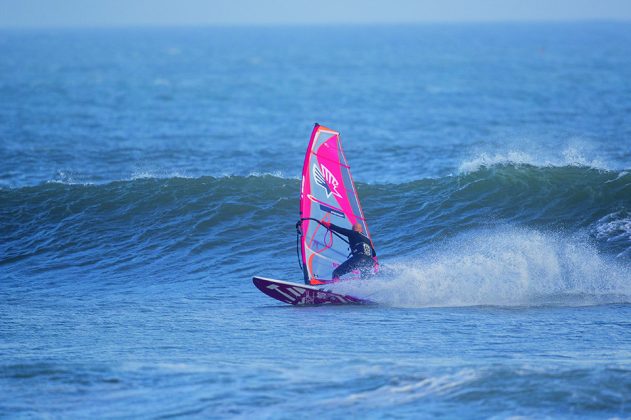JEM HALL
MOVE ON UP – WINDSURFING TECHNIQUE
FRONTSIDE FOCUS
This month I would like to give you some key areas, actions, strategies and moves that I suggest you focus on in order to get the very best out of your frontside (FS) wave riding sessions.
Words Jem Hall // Photos Clark Merritt, Noah Garrett
www.jemhall.com
(This feature originally appeared in the November December 2017 issue of Windsurf Magazine. To read more features like this first, Print and Digital subscriptions
are available. Prices include delivery globally for 10 x issues a year!)
Let’s classify what this FS riding is all about, it means making turns on a wave with your front facing the wave and means that you are turning downwind, carrying more speed, and giving you more opportunity to have fun and enjoy the finest part of our great sport! I have learnt a huge amount of what I present here from coaching people on my wave clinics and then presenting video clips of their actions to them. The people I coach range from first time riders to advanced rippers who are working on better aerials and turning more vertical. One of my favourite questions before people head out is ‘What is the most important thing to do today?’. The answers are often very technique oriented and so I remind them that what is vital is to have a game plan, and that they should be constantly reviewing and appraising this plan. In tougher conditions I often give them the game plan and in easier conditions I ask them as a group to tell me their game plans. Have a plan and execute the plan!
Catching
Hitching a ride on the way in is easy when you are powered up with medium speed waves, but if you go down to sub planing winds with bigger and faster waves then you have to be really be on your game. Again you need some aggression and risk taking here so let me give you some tips for catching waves and actions to take:
• If on the way out you see a nice open set and are not too far away from reaching your normal take off zone (Bus Stop) then take the risk of tacking or gybing, onto the wave. Yes you may fall in but this will spur you on to get better at your transitions and the feeling of turning around to catch a wave and then going straight into a ride is amazing!
• If you are too far in from where you have observed most of the regular sets are breaking and not on a wave, then go back out to the Bus Stop and wait for your ride in. Never waste a run in without catching a wave, be patient.
• Pump early and effectively – time and again I see people pump late and badly on to a wave and then they miss it and so the next wave will either be broken and un-rideable or it will take them to the cleaners. Pump with extended arms, a rowing motion and with a very bent back leg.
• After catching the wave get into your straps at the top of the wave, AKA observation point and energy zone. Stall atop the wave with ‘surfing’ skills i.e. not sheeting in too much, almost slightly sheeting out whilst pulling down on the boom with bent legs. This will stop you racing too far in front of the wave with wind power.
• Get on the right part of the wave to give you speed and positioning to then be ready to drop into a suitable part of the wave. Note this may be well upwind or downwind of you so take a good look as to where you should be on the wave and good and early too.
• Note and reflect upon changes in the conditions as either the tide, wind, wave size and wave speed changes. This may require a change of strategy or technique.
• Lastly, where you launch might not be the best place to catch waves and might actually be quite busy so sometimes you have to break free from the crowds and lead and not follow.
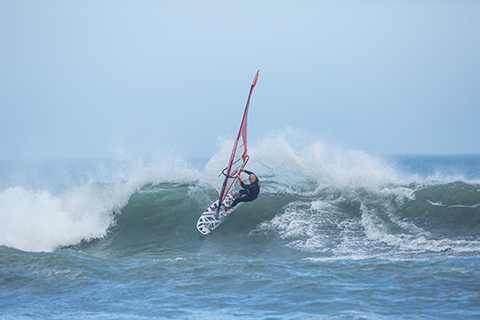
Look, low & lean in the top turn, carving pressure going from front to back foot.
PHOTO Noah Garrett

Spot the opportunity and go for an aerial’
PHOTO Noah Garrett
Kit
Generous straps to allow feet in to bear board away and get your toes down.
Long lines enable you to sail fast over bumpy water and with your front hand back, which aids getting the rig across.
Multi-fin setups that turn will help you wave ride better. Fast single fin setups just get you planing.
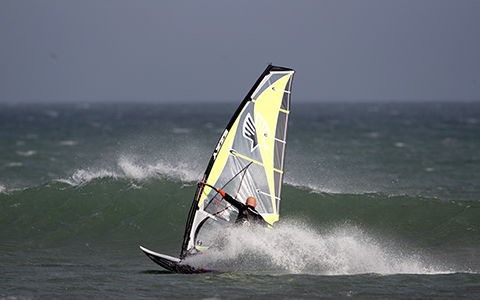
To hit some peaks you have to drive and turn tighter.
PHOTO Clark Merritt
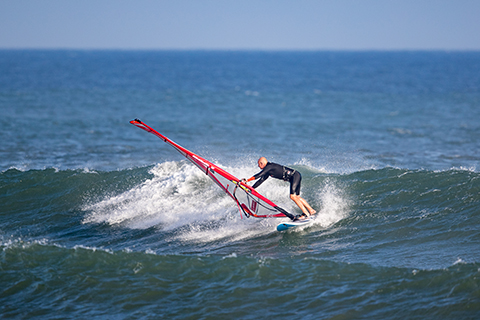
Setting up with a backside turn can often put you in a better position for a frontside hit.
PHOTO Clark Merritt
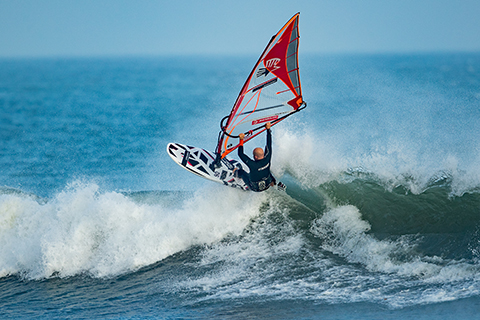
To improve you have to attack and hit that white stuff.
PHOTO Clark Merritt
Conditions
Medium sized waves that have some steepness to them but not that threatening.
A good wave period of 10 seconds or more will yield more space between the waves.
Go to the right spot to get the right conditions.
Side shore to side off is best.
On the wave
Now it is game time as you have got out the back and caught your wave but before you thrash off downwind and wiggle yourself to a frenzy on the wave (maybe actually a ripple) let’s have some clear areas to focus on:
• Wait. The wave needs time to wall up, gain energy, and get a face to it and when it does then you drop down, crucially, from the top of the wave so you gain speed and lighten the sail to make your first and following turns easy and fast.
• Or GO. As it gets bigger I see people get ‘paralysis by analysis’, I can almost hear their self-dialogue. Go relatively early and get a nice blue wall to work with and likely more sections as you carry on with your ride.
• Concentrate on one part of the waveride to improve. We cannot focus on the bottom turn, the drive and the hit all in one turn. On some days I just work on the bottom turn, others on driving up to get vertical and lastly on hitting sections, and yes I get all these wrong but I relish my ‘learning opportunities’ (swims). So please do what your coach suggests.
• Roll and attack. Your bottom turn is the most important part of the wave ride so ensure you roll into it, drive the sail forward, with your hands back and front knee / ankle really bent.
• Open the sail and swing the clew out in the drive phase as your hips move across and back, this is just like in a Step Carve Gybe. It allows you to drive off the back foot to get back up the wave and also stops you over sheetingthe sail.
• Look / Low / Lean. In the top turn focus on LOOKING out, keeping LOW as you LEAN outboards so you can bank (carve) the board off
your heels.
• Carve. In both bottom and top turn know that you should carve in on the front foot and then move to the back foot carving out of the turn. This sets the rail, keeps speed and gives you options in the arc of a turn.
• Work with the wave. Some sections break faster so you may need a shorter, tighter turn to get the hit, another section may require you to cutback so you get back to the curl and do not outrun the section, you might have to do a backside setup turn in order to get upwind of a section, and sometimes you have to go for it and slide over a lip to get round a section.
• Hit it. We need to get back up the wave and hit the steeper sections to get energy and speed back from the wave and to get some excitement too. As you move on up you will need to hit the lip later and on bigger sections. As you are improving, hit some white water sections and realise it’s not that scary.
• Aerials. Do them! Fly along the wave after spotting a section and do a half turn / jump off a steeper (but not deathly) section and enjoy.
• Gu Screw. Try these. Come out in front, go vertical up and off the wave and spin the board around, simples.
• Move your hands. Move your hands on the boom. For the bottom turn get your backhand way back on the boom, and then in the top turn slide your back hand up to your rear harness line. Think ‘Surf the boom.’ Look and keep low on every wave and in every turn and never spray watch.
• Exit plan. As presented many times before have an exit plan about how and where to get off the wave to remain upright and facilitate getting out the back smoothly.
HANG-UPS
I see people carry a lot of their flat water hang-ups into wavesailing, which will not help your journey. Therefore lose these habits:
• Not bearing away enough to get planing.
• Not working hard enough to get upwind, planing or non-planing.
• Unhooking by raising your hips. Bend your arms to hook in and out.
• Letting the wind do the work. Be proactive as a wavesailor.
• Sailing with the front hand forward on the boom, a hang up from short lines. Front hand goes next to or near your front line.
• Back hand not far enough back in gybes and therefore waverides too.
• Gear gazing. It is beautiful out there so take a good look around.
RRD boards, wetsuits, softwear, Ezzy sails & Black Project Fins sponsor Jem Hall. Get him live and direct on one of his highly acclaimed coaching holidays but be quick as they are selling out – check out his website www.jemhall.com for details. You can also follow him on twitter / Facebook/Instagram.

